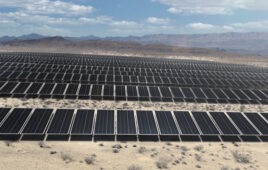A new report from The Nature Conservancy offers guidance and policy recommendations to address barriers to clean energy development on former mines, industrial sites and other brownfields. The “Mining the Sun” report is timely because a rapid transition to clean energy must occur to meet U.S. net zero goals by 2050, and siting on mines and other industrialized areas can be a way for renewable projects to be completed faster and with lower community conflict. Across the United States, there are up to 20 million acres of mine lands and brownfields suitable for new clean energy projects, enough to meet the energy needs of most U.S. homes each year.
“These sites are often already cleared and graded, and frequently have electric lines and other infrastructure that make the area suitable to build,” says Nels Johnson, TNC senior practice advisor of renewable energy deployment and lead author of the Mining the Sun report. “They also provide a new, productive use to mines that have closed and can provide tax revenue to the local community. Siting renewables on former industrial sites holds great promise for the energy transition.”
Despite these advantages, nationwide there are only 500 wind and solar projects located on brownfields — most small. Due to a host of factors — such as the cost of cleaning up potential contamination, legal and liability risks and ownership complexities — these sites have largely been avoided as a clean energy resource. But when industrialized lands are prioritized for clean energy, it can reduce the amount of natural and agricultural land needed for the energy transition.
“We know that people value natural areas and their local farms,” says Beth Wheatley, TNC Deputy Director of the North America Climate Mitigation Program. “’Mining the Sun’ can help reduce how much these lands are needed for the energy transition. Prioritizing mines and other industrialized lands for the renewable energy buildout can ease the pressure of converting natural and agricultural lands, helping accelerate the energy transition in a way that makes sense for nature, communities and developers.”
“Mining the Sun” lays out the state and federal incentives that have transformed brownfields renewables into an economically viable proposition. The Inflation Reduction Act includes a 10% tax credit to site clean energy on brownfields, along with $250 billion to repurpose old coal and oil infrastructure for clean energy. The Infrastructure Investment and Jobs Act provides $500 million for large-scale wind and solar demonstration projects on former mine lands. Grant opportunities such as the Abandoned Mine Land program and the U.S. Environmental Protection Agency’s Brownfield Program can further reduce the cost of building on former industrial lands.
The report offers an in-depth analysis of brownfields clean energy development potential in nine states: Illinois, Indiana, Kentucky, Nevada, North Dakota, Ohio, West Virginia, Wyoming and Virginia. Together, these states represent the country’s spectrum of mine land and brownfield conditions, including hardrock mines, coal mines and former industrial zones and landfills. These state-level analyses include the acreage and type of development-appropriate industrial lands, detailed state and federal policy recommendations and best practices for engaging local communities.
“These states have a long legacy of contributing to the country’s energy and industrial needs, whether it’s coal mines in Kentucky or oil fields in North Dakota,” says Wheatley. “Utility-scale renewable development is a way to honor and continue this legacy by producing clean, reliable energy that safeguards our air and climate. It also allows communities to voice how they would like to benefit from the project. That could mean the potential to create jobs, the addition of outdoor recreation opportunities, or something else meaningful to the community.”
TNC has catalyzed several “Mining the Sun” projects, aiming to demonstrate that these projects are financially viable in many regions across the country. The Cumberland Forest Project is featured in the report as a case study. Located in the Appalachian mountains, the project includes 253,000 acres under management by TNC with 40,000 of those acres being former coal mining lands. TNC began managing this land in 2019 and has signed solar development agreements with two Virginia-based energy companies: Sun Tribe Development and Dominion Energy. Eight lease option agreements are now in place across 1,000 acres, with a planned generation of 130 MW. TNC and solar developers have also agreed to an additional community benefits plan that will inform other investments that developers will make in community-identified priorities. This project is among the first to take advantage of federal incentives by developing renewable energy on mine lands in the Central Appalachians.
“The United States cannot meet its energy and climate goals without the rapid deployment of large-scale renewable energy installations. Renewable energy development on mine lands is not a silver bullet, but it is an exceptionally promising avenue to produce clean energy in a way that respects communities and local landscapes,” says Johnson. “We encourage renewable energy developers, electric utilities, policymakers and regulators to read the report so they can learn more about the opportunities to site clean energy on mines and brownfields in their communities.”
News item from TNC






Tell Us What You Think!